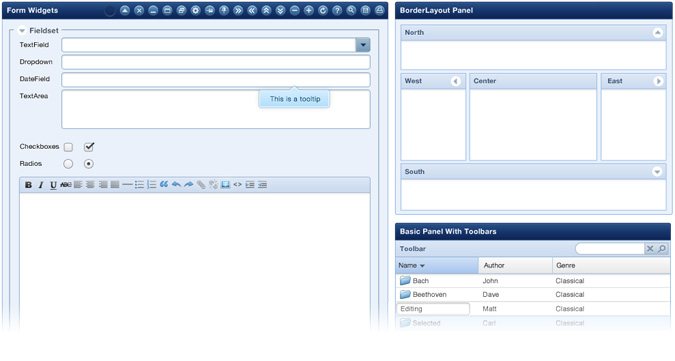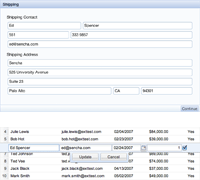Ext JS 4 preview: faster, easier, more stable
 The creators of the beautiful Ext JS / Sencha framework at the Ext JS conference announced the release of the 4th version. This article is a free translation of a post from the blog developers. In the new version, there are a lot of changes that will not leave developers indifferent. We are waiting for a public beta.
The creators of the beautiful Ext JS / Sencha framework at the Ext JS conference announced the release of the 4th version. This article is a free translation of a post from the blog developers. In the new version, there are a lot of changes that will not leave developers indifferent. We are waiting for a public beta.New chips
')
So, let's start with the new chips that we added to Ext JS 4. Although this is not an exhaustive list of innovations, but only the most interesting features from those that will appear in the 4th version.
Charts
 Up to this point, most have used Flash-based Ext JS 3 Graphics. They are quite suitable for basic things, but very difficult to customize.
Up to this point, most have used Flash-based Ext JS 3 Graphics. They are quite suitable for basic things, but very difficult to customize.For Ext JS 4th version, we developed a completely new graphics module that is built entirely on JavaScript. We have combined the phenomenal talent of Dmitry Baranovsky (Raphaël JS) and Nicolas Belmonte (InfoVis) with our Jamie Avens to create the most powerful JavaScript-based graphing library we have ever met.
The new graphics package works on all browsers supported by Ext JS, including IE6, and is fully integrated with the rest of the framework. We will publish a more detailed description of the charting package in the coming weeks; we are really very impressed with the possibilities that this package will provide to developers.
Skins
Ext JS has always been famous for its unmatched design, but with the advent of Ext JS 4, we are taking it to a new level with a new theme: Neptune.

This theme is built on the beautiful and clean design of the current theme, but at the same time adds a visual gloss to your application.
But this is not just a new theme - in Ext JS 4 we used SASS from the very beginning, which allows you to easily customize the theme of your application. SASS is already used in Sencha Touch, so you can check the ease of customization right now.
Improved Data Package
One of the greatest strengths of Ext JS is the data packet. It is used in Stores, Readers, Proxies and other modules to load data from any sources and display them in your widgets. In the new version, we radically reworked the data packet, adding to its incredible capabilities, for example, it became possible to establish a connection between the Models and save the data to the local storage.
The Data Pack of the 4th version of Ext JS is also available for Sencha Touch, so you can use it now. We have published several blog posts ( innovations introduced ), in which we described a new data package, these articles are also relevant for the 4th version package.
Application architecture
The first thing we think about when we start developing an application is what structure to choose for it. This leads to numerous problems - our time is not spent on developing the application directly. Each developer comes to some kind of structure, inventing a bicycle each time. In the 4th version, we solve this problem by providing developers with an out-of-the-box application architecture.
An application architecture is a standardized way to build applications. All applications built in this way are based on the same patterns and have the same file structure. This allows us to use amazing tools that make it possible to automate many actions to work with the application. It's incredible how much easier it is to create applications based on the new architecture, you can look at examples for Sencha Touch: for Twitter and Kiva .
We believe that this is the most exciting part of the new version of Ext JS and I am sure that developers will be crazy about how easy it is to create applications based on it. Understandably, some already have their own ready-made architectures, so we made this chip completely optional. Of course, we will provide much more information on the application architecture before Ext JS 4 is released early next year.
Updated Components

Each component of the framework was given attention during the development of Ext JS 4. First of all, we combined the rendering (rendering) and layout (layout) of each component to unify their work. We walked through the components to fix the bugs, improving the interface and giving the appearance even more glamor. Most components have become faster and more flexible than ever.
In addition, we also added new components to the framework. The two most popular extensions - RowEditor and TreeGrid - are now built into the framework, rewritten to fully comply with the Ext JS quality standards.
End FormLayout
When we were interested in the developers, which part of Ext JS 3 made life more difficult for them, we heard complaints about the markup of forms. Forms have always been very closely related to the FormLayout component, which worked like a straitjacket, limiting form flexibility. In the 4th version of Ext JS, forms can use any markup, allowing you to achieve any kind limited only by your imagination.
ARIA, RTL and others
The two most frequent requests, if you exclude requests by component: a request for better support for ARIA (Accessible Rich Internet Applications) and better support for RTL (Right to Left). Starting with the 4th version of Ext JS, we build Section 508A (accessibility) and support for right-handed languages.
Hundreds of improvements, new chips and bug fixes are expected in Ext JS 4 - the list is too big to fit in one post. We will publish a series of articles with more detailed information, and of course the full manual will be published as soon as the new version is published.
Faster, easier, more stable
The new features are great, but when we asked the community what we need to improve in Ext JS, we received three answers: speed, reliability, and ease of use. When developing Ext JS 4, we worked on all three fronts.
Speed
Everyone is worried about speed - how fast the application loads, how long the render and layout takes, or how smart the interface works when interacting with the user. One of the most labor-intensive parts of the application is the layout. Ext JS 4 is a completely new markup engine that we developed using our entire 4-year experience in developing framework framework.
Those who could attend our conference could see how smartly the new markup engine works, and at the same time it also supports the API as Ext JS 3. And the performance is not all that the new engine can boast of, but we’ll talk more about all its features selected articles closer to release. Ext JS 4 is much faster than everything we created before.
Stability
Especially for version 4, we have made every effort to provide the most stable version of the framework.
For starters, the framework has the best test coverage ever, with hundreds of unit tests that make sure that the code works as intended.
Unit tests are only part of the overall picture, in addition to testing the code, you need to be sure that the visual components work correctly. And this is the most difficult part of the work, so for the 4th version we specifically invented a completely new tool that tests every component of the library. We brought it to the OS (Operating System) level, assuming that we would be able to test all OS-browser combinations (from among those supported by us), thus encouraging users to click on the interface. We called this tool Visual QA, and we’ll talk more about it soon.
Easy to learn and use.

Ext JS is a great framework, but too hard to learn. In the new version, we tried to fix it by providing the developers with the best documentation in the history of the framework. To check out its beauty now you can look at the documentation Sencha Touch ( some of the documentation ). This is the standard that we will follow in Ext JS 4. We will also write manuals, increase the number of examples and provide more demo applications.
In addition to the documentation, a lot of attention was paid to the API in order to standardize the rules of naming, as well as provide more meaningful default options. And finally, we will provide a version upgrade guide that will help developers to seamlessly upgrade existing applications to Ext JS 4.
Release
We have been working on Ext JS 4 for a long time and feverishly, and are now excited before the publication of the first beta version, which is coming in a few weeks. The framework is already more reliable than ever, and we cannot wait for the moment when we give it a “touch” to you. We want to release several beta versions early next year, and the final release is scheduled for February 28, 2011 .
I hope you are also excited and impressed with the new features of the new version of Ext JS, and will support us in the web application development revolution.
Source: https://habr.com/ru/post/108659/
All Articles